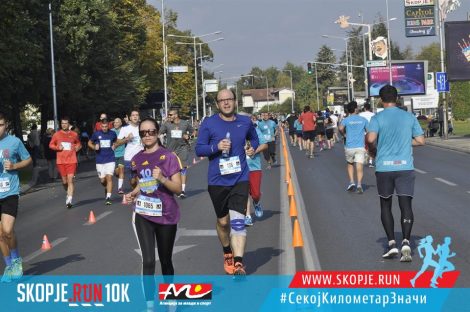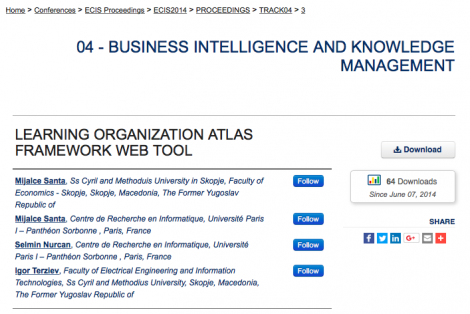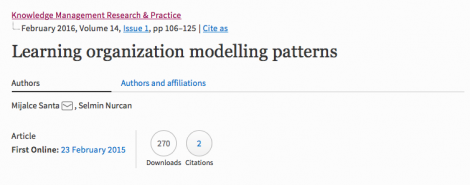For the second time I have run 10km on Skopje.Run.10k. This time faster – 1H 3M 14S 🙂
A Systems Approach to Evaluate One Health Initiatives
Challenges calling for integrated approaches to health, such as the One Health (OH) approach, typically arise from the intertwined spheres of humans, animals, and ecosystems constituting their environment. Initiatives addressing such wicked problems commonly consist of complex structures and dynamics. As a result of the EU COST Action (TD 1404) “Network for Evaluation of One Health” (NEOH), we propose an evaluation framework anchored in systems theory to address the intrinsic complexity of OH initiatives and regard them as subsystems of the context within which they operate. Typically, they intend to influence a system with a view to improve human, animal, and environmental health. The NEOH evaluation framework consists of four overarching elements, namely: (1) the definition of the initiative and its context, (2) the description of the theory of change with an assessment of expected and unexpected outcomes, (3) the process evaluation of operational and supporting infrastructures (the “OH-ness”), and (4) an assessment of the association(s) between the process evaluation and the outcomes produced. It relies on a mixed methods approach by combining a descriptive and qualitative assessment with a semi-quantitative scoring for the evaluation of the degree and structural balance of “OH-ness” (summarised in an OH-index and OH-ratio, respectively) and conventional metrics for different outcomes in a multi-criteria-decision-analysis. Here, we focus on the methodology for Elements (1) and (3) including ready-to-use Microsoft Excel spreadsheets for the assessment of the “OH-ness”. We also provide an overview of Element (2), and refer to the NEOH handbook for further details, also regarding Element (4) (http://neoh.onehealthglobal.net). The presented approach helps researchers, practitioners, and evaluators to conceptualise and conduct evaluations of integrated approaches to health and facilitates comparison and learning across different OH activities thereby facilitating decisions on resource allocation. The application of the framework has been described in eight case studies in the same Frontiers research topic and provides first data on OH-index and OH-ratio, which is an important step towards their validation and the creation of a dataset for future benchmarking, and to demonstrate under which circumstances OH initiatives provide added value compared to disciplinary or conventional health initiatives.
Full paper at https://doi.org/10.3389/fvets.2018.00023
Modeling the creation of a Learning organization by using the Learning Organization Atlas Framework
In a continuously changing external environment, the learning organization can provide a competitive advantage. However, the concept has been largely criticized for the lack of guidelines and tools on how it could be developed. This undermines the opportunity for the development of the learning organization. This paper aims to contribute toward the debate on its creation by proposing a Learning Organization Atlas Framework approach. This framework comprises of the facets of the learning organization that characterize them, a Learning Organization Grid for the analysis and benchmarking of organizations, a Learning Organization Atlas that can be used for developing models of them, and a Learning Organization Road Map that includes the intentions of the organization and the strategies to achieve those intentions. With the framework and its four elements, we propose a method for modeling the learning organization and organizational change by providing embedded flexibility. The next level for research is in identifying the influence between different facets, strategy selection, and development of guidelines for models of learning organizations.
Full paper at https://hal-paris1.archives-ouvertes.fr/hal-01227451/
Learning Organization Atlas Framework Web Tool
The learning organization is recognized as a concept that can improve the competitiveness of the organization. However, there is lack of tools that will assist the development of the learning organization. We present the Learning Organization Atlas Framework web tool that can be used to assist the development of the learning organization. The tool consists of four parts: identify, atlas, \ alignment and roadmap. Through these parts the organization can benchmark itself against the characteristics of the learning organization, identify how the organization is aligned for different facets and entities, and identify strategies and actions that can be used to become a learning organization.
Hidden Champions of the Republic of Macedonia
The Republic of Macedonia is a small landlocked country with nice people, tasty food, and a lot of sunny days. Throughout its history, the present-day territory of Macedonia has been a crossroads for both traders and conquerors moving between the European continent and
Asia Minor. Each of these transiting powers has left its mark upon the region, giving rise to a rich and varied cultural and historical tradition. For over 500 years, until 1912, Macedonia was under the rule of the Ottoman Turkish Empire. After the Second Balkan War, the territory
of Macedonia was divided between Bulgaria, Greece, and Serbia. After that, the present-day area of the Republic of Macedonia was incorporated into the newly formed Kingdom of Serbs, Croats, and Slovenes. After the Second World War, the Republic of Macedonia
became one of the constituent republics of the new Socialist Federal Republic of …
Full text at https://link.springer.com/chapter/10.1007%2F978-3-642-40504-4_16
Learning organisation review – a “good” theory perspective
The purpose of this paper is to perform integrative literature review of the learning organisation (LO) concept, on the basis of the results of the literature review to assess the concept on the principles of “good” theory, and provide future avenues for LO concept clarification and development.
Full paper at http://www.emeraldinsight.com/doi/full/10.1108/TLO-12-2014-0067
Learning Organisation Modelling Patterns
In a continuously changing external environment the learning organization can provide a competitive advantage. However, the concept has been largely criticized for lack of conceptual clarity and operational imprecision. This has strongly undermined the possibility for development of learning organization models. The aim of this paper is to identify the generative mechanism of the learning organization by applying pattern-oriented modelling. This is achieved through development of a learning organization conceptual model that contains learning as a central domain supported by an additional 10 domains organized into four pillars: direction (vision and strategy), infrastructure (structure, technology and processes), informal (culture, power, politics) and change (leadership and change). Through development of patterns for each domain of the model, the Learning Levels and the relation ‘transcend and embed’ were identified as generative mechanisms of the learning organization.
Full paper at https://link.springer.com/article/10.1057/kmrp.2014.22






